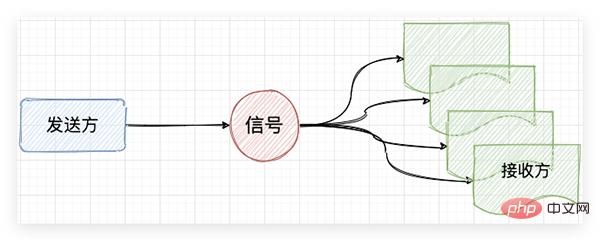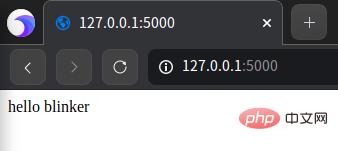Python's powerful signal library: blinker

1. Signal
Hello everyone, I am my old cousin~
A signal is a way of notification or communication. Signals are divided into sending party and receiver. The sender sends a signal, and the process of the receiver receiving the signal will jump into the signal processing function. After execution, it will jump back to the original position to continue execution.
Common signals in Linux, inputting Ctrl C through the keyboard is to send a signal to the system to tell the system to exit the current process.
The characteristic of a signal is that the sender notifies the subscriber of what happened. Using signals is divided into 3 steps: defining signals, monitoring signals, and sending signals.

#The communication module that provides the signal concept in Python is blinker.
Blinker is a powerful signal library based on Python, which supports both simple point-to-point communication and point-to-multipoint multicast. Flask's signaling mechanism is based on it. Although the kernel of Blinker is small, it is very powerful. It supports the following features:
- Supports registration of global named signals
- Supports anonymous signals
- Supports custom naming Signal
- Supports persistent connections and short-lived connections with the receiver
- Implements automatic disconnection with the receiver through weak references
- Supports sending any size Data
- Supports collecting the return value of the signal receiver
- Thread safety
2. Blinker uses the
installation method:
pip install blinker
2.1 Named signal
from blinker import signal
# 定义一个信号
s = signal('king')
def animal(args):
print('我是小钻风,大王回来了,我要去巡山')
# 信号注册一个接收者
s.connect(animal)
if "__main__" == __name__:
# 发送信号
s.send()

2.2 Anonymous signal
blinker also supports anonymous signals, that is, there is no need to specify a specific signal value. Each anonymous signal created is independent of each other.
from blinker import Signal
s = Signal()
def animal(sender):
print('我是小钻风,大王回来了,我要去巡山')
s.connect(animal)
if "__main__" == __name__:
s.send()
2.3 Multicast signal
Multicast signal is a characteristic that can better reflect the advantages of signals. Multiple receivers are registered to the signal, and the sender only needs to send once to deliver information to multiple receivers.
from blinker import signal
s = signal('king')
def animal_one(args):
print(f'我是小钻风,今天的口号是: {args}')
def animal_two(args):
print(f'我是大钻风,今天的口号是: {args}')
s.connect(animal_one)
s.connect(animal_two)
if "__main__" == __name__:
s.send('大王叫我来巡山,抓个和尚做晚餐!')

2.4 The receiver subscribes to the topic
The receiver supports subscribing to the specified topic, and only when the specified topic sends a message, it is sent to the receiver. This method distinguishes different topics well.
from blinker import signal
s = signal('king')
def animal(args):
print(f'我是小钻风,{args} 是我大哥')
s.connect(animal, sender='大象')
if "__main__" == __name__:
for i in ['狮子', '大象', '大鹏']:
s.send(i)

2.5 Decorator Usage
In addition to function registration, there is a simpler signal registration method, that is, decorator.
from blinker import signal
s = signal('king')
@s.connect
def animal_one(args):
print(f'我是小钻风,今天的口号是: {args}')
@s.connect
def animal_two(args):
print(f'我是大钻风,今天的口号是: {args}')
if "__main__" == __name__:
s.send('大王叫我来巡山,抓个和尚做晚餐!')
2.6 Decorators that can subscribe to topics
Connect's registration method has a drawback when using decorators, which is that it cannot subscribe to topics, so there is a more advanced connect_via method that supports subscribing to topics.
from blinker import signal
s = signal('king')
@s.connect_via('大象')
def animal(args):
print(f'我是小钻风,{args} 是我大哥')
if "__main__" == __name__:
for i in ['狮子', '大象', '大鹏']:
s.send(i)
2.7 Check whether there is a receiver for the signal
If it takes a long time for a sender to prepare before sending a message, in order to avoid the waste of performance caused by no receiver, you can first Check whether there is a receiver for a certain signal, and only send it when it is confirmed that there is a receiver, so as to be accurate.
from blinker import signal
s = signal('king')
q = signal('queue')
def animal(sender):
print('我是小钻风,大王回来了,我要去巡山')
s.connect(animal)
if "__main__" == __name__:
res = s.receivers
print(res)
if res:
s.send()
res = q.receivers
print(res)
if res:
q.send()
else:
print("孩儿们都出去巡山了")
{4511880240: <weakref at 0x10d02ae80; to 'function' at 0x10cedd430 (animal)>}
我是小钻风,大王回来了,我要去巡山
{}
孩儿们都出去巡山了
2.8 Check whether the subscriber is subscribed to a certain signal
You can also check whether the subscriber is subscribed to a certain signal
from blinker import signal
s = signal('king')
q = signal('queue')
def animal(sender):
print('我是小钻风,大王回来了,我要去巡山')
s.connect(animal)
if "__main__" == __name__:
res = s.has_receivers_for(animal)
print(res)
res = q.has_receivers_for(animal)
print(res)
True False
3. Flask signal based on blinker
Flask integrates blinker as a solution for decoupled applications. In Flask, the usage scenarios of signals are as follows: before the request arrives and after the request ends. At the same time, Flask also supports custom signals.
3.1 Simple Flask demo
from flask import Flask
app = Flask(__name__)
@app.route('/',methods=['GET','POST'],endpoint='index')
def index():
return 'hello blinker'
if __name__ == '__main__':
app.run()
When accessing 127.0.0.1:5000, return hello blinker to the browser.
3.2 Custom signals
Because Flask integrates signals, they are imported from Flask when using signals in Flask.
from flask import Flask
from flask.signals import _signals
app = Flask(__name__)
s = _signals.singal('msg')
def QQ(args):
print('you have msg from QQ')
s.connect(QQ)
@app.route('/',methods=['GET','POST'],endpoint='index')
def index():
s.send()
return 'hello blinker'
if __name__ == '__main__':
app.run()

3.3 Flask’s own signals
In addition to customizing signals, you can also use built-in signals in Flask. There are many kinds of signals that come with Flask, as follows:
请求
request_started = _signals.signal('request-started')# 请求到来前执行
request_finished = _signals.signal('request-finished')# 请求结束后执行
模板渲染
before_render_template = _signals.signal('before-render-template')# 模板渲染前执行
template_rendered = _signals.signal('template-rendered')# 模板渲染后执行
请求执行
got_request_exception = _signals.signal('got-request-exception')# 请求执行出现异常时执行
request_tearing_down = _signals.signal('request-tearing-down')# 请求执行完毕后自动执行(无论成功与否)
appcontext_tearing_down = _signals.signal('appcontext-tearing-down') # 请求上下文执行完毕后自动执行(无论成功与否)
请求上下文中
appcontext_pushed = _signals.signal('appcontext-pushed')# 请求上下文push时执行
appcontext_popped = _signals.signal('appcontext-popped')# 请求上下文pop时执行
message_flashed = _signals.signal('message-flashed')# 调用flask在其中添加数据时,自动触发
The following takes before the request arrives as an example to see how to use signals in Flask
from flask import Flask
from flask.signals import _signals, request_started
import time
app = Flask(__name__)
def wechat(args):
print('you have msg from wechat')
# 从flask中引入已经定好的信号,注册一个函数
request_started.connect(wechat)
@app.route('/',methods=['GET','POST'],endpoint='index')
def index():
return 'hello blinker'
if __name__ == '__main__':
app.run()
When a request arrives, Flask will go through request_started Notifying the recipient is the function wechat. At this time, the wechat function is executed first and then returns the result to the browser.

But this method of use is not very authentic, because signals do not support asynchronous methods, so usually the receivers of signals in production environments are frameworks configured for asynchronous execution, such as the famous asynchronous framework celery in Python.
4. Summary
Advantages of signals:
- Decoupled applications: Decompose serially running coupled applications into multi-level execution
- Publish Subscribers: Reduce the use of callers, notify multiple subscribers with one call
Disadvantages of signals:
- Does not support asynchronous
- Supports subscriptions The theme's capacity is limited
Every like, view, message, and retweet of yours is very important to me, thank you for your support.
Okay, see you next time. I love cats, technology, and Sisi’s old cousin even more⁽⁽ଘ( ˙꒳˙ )ଓ⁾⁾
The above is the detailed content of Python's powerful signal library: blinker. For more information, please follow other related articles on the PHP Chinese website!

Hot AI Tools

Undresser.AI Undress
AI-powered app for creating realistic nude photos

AI Clothes Remover
Online AI tool for removing clothes from photos.

Undress AI Tool
Undress images for free

Clothoff.io
AI clothes remover

Video Face Swap
Swap faces in any video effortlessly with our completely free AI face swap tool!

Hot Article

Hot Tools

Notepad++7.3.1
Easy-to-use and free code editor

SublimeText3 Chinese version
Chinese version, very easy to use

Zend Studio 13.0.1
Powerful PHP integrated development environment

Dreamweaver CS6
Visual web development tools

SublimeText3 Mac version
God-level code editing software (SublimeText3)

Hot Topics
 1666
1666
 14
14
 1425
1425
 52
52
 1328
1328
 25
25
 1273
1273
 29
29
 1253
1253
 24
24
 PHP and Python: Different Paradigms Explained
Apr 18, 2025 am 12:26 AM
PHP and Python: Different Paradigms Explained
Apr 18, 2025 am 12:26 AM
PHP is mainly procedural programming, but also supports object-oriented programming (OOP); Python supports a variety of paradigms, including OOP, functional and procedural programming. PHP is suitable for web development, and Python is suitable for a variety of applications such as data analysis and machine learning.
 Choosing Between PHP and Python: A Guide
Apr 18, 2025 am 12:24 AM
Choosing Between PHP and Python: A Guide
Apr 18, 2025 am 12:24 AM
PHP is suitable for web development and rapid prototyping, and Python is suitable for data science and machine learning. 1.PHP is used for dynamic web development, with simple syntax and suitable for rapid development. 2. Python has concise syntax, is suitable for multiple fields, and has a strong library ecosystem.
 How to run sublime code python
Apr 16, 2025 am 08:48 AM
How to run sublime code python
Apr 16, 2025 am 08:48 AM
To run Python code in Sublime Text, you need to install the Python plug-in first, then create a .py file and write the code, and finally press Ctrl B to run the code, and the output will be displayed in the console.
 PHP and Python: A Deep Dive into Their History
Apr 18, 2025 am 12:25 AM
PHP and Python: A Deep Dive into Their History
Apr 18, 2025 am 12:25 AM
PHP originated in 1994 and was developed by RasmusLerdorf. It was originally used to track website visitors and gradually evolved into a server-side scripting language and was widely used in web development. Python was developed by Guidovan Rossum in the late 1980s and was first released in 1991. It emphasizes code readability and simplicity, and is suitable for scientific computing, data analysis and other fields.
 Python vs. JavaScript: The Learning Curve and Ease of Use
Apr 16, 2025 am 12:12 AM
Python vs. JavaScript: The Learning Curve and Ease of Use
Apr 16, 2025 am 12:12 AM
Python is more suitable for beginners, with a smooth learning curve and concise syntax; JavaScript is suitable for front-end development, with a steep learning curve and flexible syntax. 1. Python syntax is intuitive and suitable for data science and back-end development. 2. JavaScript is flexible and widely used in front-end and server-side programming.
 Golang vs. Python: Performance and Scalability
Apr 19, 2025 am 12:18 AM
Golang vs. Python: Performance and Scalability
Apr 19, 2025 am 12:18 AM
Golang is better than Python in terms of performance and scalability. 1) Golang's compilation-type characteristics and efficient concurrency model make it perform well in high concurrency scenarios. 2) Python, as an interpreted language, executes slowly, but can optimize performance through tools such as Cython.
 Where to write code in vscode
Apr 15, 2025 pm 09:54 PM
Where to write code in vscode
Apr 15, 2025 pm 09:54 PM
Writing code in Visual Studio Code (VSCode) is simple and easy to use. Just install VSCode, create a project, select a language, create a file, write code, save and run it. The advantages of VSCode include cross-platform, free and open source, powerful features, rich extensions, and lightweight and fast.
 How to run python with notepad
Apr 16, 2025 pm 07:33 PM
How to run python with notepad
Apr 16, 2025 pm 07:33 PM
Running Python code in Notepad requires the Python executable and NppExec plug-in to be installed. After installing Python and adding PATH to it, configure the command "python" and the parameter "{CURRENT_DIRECTORY}{FILE_NAME}" in the NppExec plug-in to run Python code in Notepad through the shortcut key "F6".





